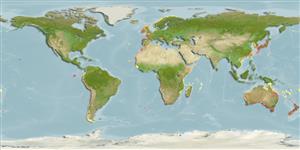Pyura stolonifera (Heller, 1878)
Red bait| Native range | All suitable habitat | Point map | Year 2050 |

|
| This map was computer-generated and has not yet been reviewed. |
| Pyura stolonifera AquaMaps Data sources: GBIF OBIS |
Google image |
No photo available for this species.
Classification / Names Populärnamn | synonymer | CoL | ITIS | WoRMS
Ascidiacea | Stolidobranchia | Pyuridae
Environment: milieu / climate zone / djupintervall / distribution range Ekologi
; djupintervall 0 - 15 m (Ref. 113256). Tropical, preferred 17°C (Ref. 107945)
Distribution Länder | FAO områden | Ekosystem | Förekomster | Utplanteringar
Eastern Atlantic, Indo-West Pacific, and the Antarctic: Equatorial west coasts of South America and west and southeast Africa. tropical to temperate.
Length at first maturity / Size / Weight / Age
Könsmognad: Lm ? range ? - ? cm Max length : 40.0 cm TL hane/ej könsbestämd; (Ref. 101433)
Life cycle and mating behavior Könsmognad | Reproduktion | Lek | Eggs | Fecundity | Larvae
Main reference
referenser | Koordinator | Medarbetare
Kott, P. 2005 Catalogue of Tunicata in Australian Waters. Queensland Museum, Brisbane, Australia Department of the Environment and Heritage. (Ref. 1134)
IUCN Red List Status
(Ref. 130435: Version 2025-1)
CITES status (Ref. 108899)
CMS (Ref. 116361)
Threat to humans
Human uses
Fiskeri: kommersiell
FAO - Vattenbruk: production; fiskeri: landings | FishSource | Sea Around Us
Verktyg
Ytterligare information
Max. ages / sizes
Length-weight rel.
Length-length rel.
Length-frequencies
Mass conversion
Abundans
Internet-källor
BHL | BOLD Systems | CISTI | DiscoverLife | FAO(fiskeri: ; publication : search) | Fishipedia | GenBank (genome, nucleotide) | GloBI | Gomexsi | Google Books | Google Scholar | Google | PubMed | Tree of Life | Wikipedia (Go, sök) | Zoological Record


